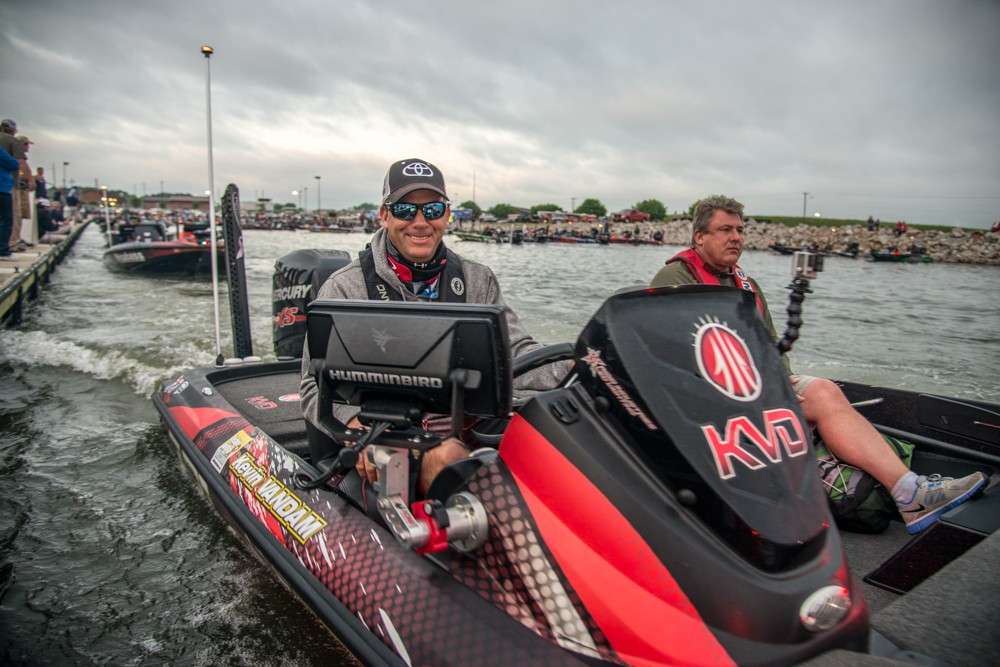
In last week’s blog I mentioned my experiences with the HydroWave during the Bassmaster Elite tournament at Wheeler and said I’d delve into the details of HydroWave usage this week.
After Wheeler, I participated in a TH Marine media event. The HydroWave, which is now under TH Marine ownership, was a big topic of discussion among the writers at Guntersville. It always draws a lot of questions from anglers when I’m doing seminars. Perhaps I can answer some of those questions here.
I’ve been involved with HydroWave from the beginning and have seen what it can do for my fishing. Like all fishing equipment, the technology has improved substantially each year.
But don’t assume it’s a “fish call” that drives bass wild. It’s not going to draw every fish to your lure or make them bite every time. What it does – and I’ve seen it happen many times – is manipulate the mood and activity of baitfish and bass when used in the appropriate situation. When you get baitfish and bass riled, good things happen.
How does it do it?
The HydroWave uses actual sound patterns recorded of baitfish and/or bass feeding on bait and emits those recordings through a speaker strapped to the trolling motor head. There are several sound patterns, each one designed for specific situations. It’s up to the angler to assess the conditions and choose the appropriate pattern.
I run my unit every minute I’m fishing, but I always preset the sounds to match conditions beforehand. I consider weather, seasonal pattern, water clarity and the forage base on that lake. It’s similar to how I choose a lure, lure colors and how I present them. Match the hatch, you know?
The objective is to create a natural sound for the underwater world to activate fish. The sounds emulate nervous baitfish or bass feeding on baitfish.
There are settings for shad, crawfish, shiners and blue herring in different scenarios. For example, you can run one for deep baitfish, baitfish in lily pads, shad spawn, bluegill spawn crawfish on rocks and many more.
The company is constantly updating and adding new sounds. They are recorded in lakes around the country under specific conditions to get the precise natural sounds.
I choose a sound pattern that matches the conditions. If there is wind and cloud cover and conditions are conducive for active bass, I will run a more aggressive pattern. If it’s slick and sunny, I will opt for subtle, low key finesse sound mixes. If I’m fishing ledges, I will use the deep baitfish pattern.
One mistake anglers make is they think louder is better, but that’s not the case. Sound travels farther than you think underwater, so I rarely go higher than 60 percent on the sound, and that’s only when there is a lot of wind and underwater background noise. Most of the time I’m at 20 percent volume.
I’m not trying to get every bass or baitfish in the lake to hear my sounds, just those within close proximity of where I’m fishing.
I often run my sound patterns on a delay, meaning the sound will turn on and off in 30-second intervals. Imagine bass sitting on a point or in brush piles with baitfish around. When that sound goes off, the bait gets nervous and the bass start chasing. That’s what can trigger the bite because it replicates what goes on in nature.
I’m not the only believer, as most Elite anglers are using them and they’re not getting paid to endorse it. They’re constantly sharing stories about their experiences.
Again, the HydroWave is just a tool like anything else used in fishing. When used properly and under the right conditions, you can activate fish or keep them active for longer periods. And the more you use it, the more confidence you will gain in what works best for you.
Remember, it’s all about the attitude!
Kevin VanDam’s column appears weekly on Bassmaster.com. You can also find him on Facebook, Twitter and Instagram.

